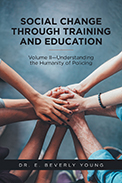
 |
Social Change Through Training and Education: Volume II—Understanding the Humanity of Policing
by Dr. E. Beverly Young
AuthorHouse
This simple but cogent manual for all parties involved in law enforcement stresses that communication is the first essential since policing is a partnership. The police are accountable to the community just as its citizens are, and all must communicate. This involves not only speaking but also the “bidirectional” requirement to listen and understand. Both citizens and police must be aware of and control their nonverbal cues: hand gestures, eye contact, and other subtle actions. Though at times they must take charge, police are not merely supposed to give orders. This misperception can lead to their seeming harsh, condescending, and even prejudiced. Police authoritarianism can provoke racial fears. To promote what Young calls “communication wellness,” law enforcement personnel and residents must form a collaboration to create compatible strategies, draw in many community players, and identify common goals.
Dr. Young “wore the badge, uniform and carried the gun for more than twenty years” before becoming an adult learning strategies consultant focusing on police and law enforcement classes. In this short volume, she methodically organizes vital information using various means to underscore her central point: policing is a two-way process. To aid readers in participating fully in that process, she offers numerous suggestions and tactics for community organization. She takes into account two essential and often ignored factors in the creation of “bidirectional” interaction: first, police must learn not to be overly-domineering and aloof in their policing style; second, racial bias and racial fears have to be acknowledged and overcome. She helpfully inserts what she terms “introspection interludes” to raise questions for self-testing on the themes presented. She concludes with useful discussion points, an overall review, and a list of suggested reading materials. In total, her book can comprise a rational starting point for community cooperation between citizens and law enforcement.
RECOMMENDED by the US Review